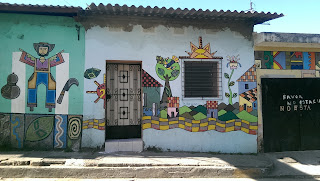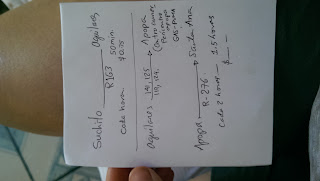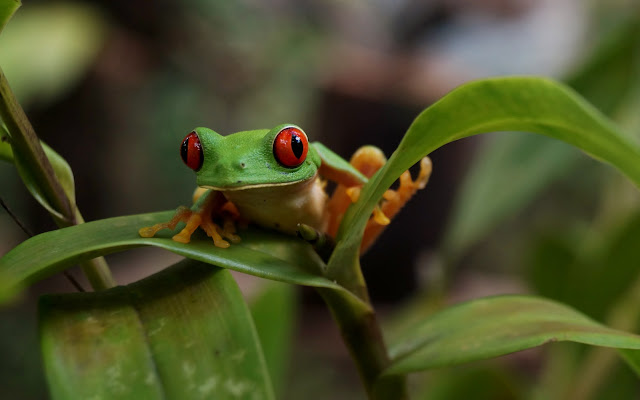The art pueblo of La Palma and our first Workaway
It seems every time I sit down to write our blog I am
apologising for the length of time between writing.
Well, it has been another long break before getting you
folks up to date with our adventures. Last time we left you we had just
finished our time in Copan Ruinas in Honduras. Our next destination was the
country of El Salvador where we had a WorkAway arranged with a tourist
cooperative called Nubes del (Clouds of) Pital.
For the uninitiated, Workaway is a website which connects
volunteers with hosts who offer accommodation and food for help on projects
such as organic farms, hostels and many more.
 Back to the story. We left Copan at what we thought was the
reasonable time of 9am in the morning, which later you will see came back to
bite us. We had many bus changes from there. The journey was longer and more
tedious than expected even with the beautiful countryside. Suffice to say after
4 long bus journeys we got to the border a lot later than expected and though
the border crossing into El Salvador was easy, we had already missed the last
bus. After a bit of wandering around we found a crew of tuk tuk drivers. For $5
one agreed to take us to our destination of La Palma where we planned to stay
for the couple of days prior to joining our WorkAway.
Back to the story. We left Copan at what we thought was the
reasonable time of 9am in the morning, which later you will see came back to
bite us. We had many bus changes from there. The journey was longer and more
tedious than expected even with the beautiful countryside. Suffice to say after
4 long bus journeys we got to the border a lot later than expected and though
the border crossing into El Salvador was easy, we had already missed the last
bus. After a bit of wandering around we found a crew of tuk tuk drivers. For $5
one agreed to take us to our destination of La Palma where we planned to stay
for the couple of days prior to joining our WorkAway.  |
| Some examples of the crazy street art in La Palma |
 |
| Freshly painted gifts at La Semilla de Dios |
The next day we took the bus to San Ignacio, the next town,
and then another bus up the mountain to Rio Chiquito, where we would meet our
WorkAway host.
On arriving at Rio Chiquito, the air was noticeably colder,
being at around 2400 feet and on the side of the highest point in El Salvador,
Cerro El Pital. After realizing we had no way of contacting our host and
meeting a couple trying to get to the same place, we met our host, Tobias, and
then jumped in the back of his truck for the quick but very bumpy drive down to
the farm.
 |
| Our cob cottage for the week- one of our tasks was to paint some cool designs on the front |
Although in the past cob was a main building material, in
many countries such as the UK, it is no longer widely used. In El Salvador, cob
structures are still built but are unfortunately associated with poverty.
Therefore, people would much rather build cement block houses which are ugly
and expensive. With a rise of interest in sustainable building, cob is making a
comeback. Nubes del Pital is creating a cooperative where they teach locals to
build cob houses which can then be used as a source of income; as hotels for
tourists. Nubes del Pital have several cob cabins which they hire out on AirBnb
and Tripadvisor. They also run flower tours and guide walks.
We were lucky enough to have a cabin to ourselves for the
week.
 |
| The almost finished shed- just needs a roof. |
Our main task for the week was to help to build a wattle and
daub animal shelter. This will eventually shelter geese, meat rabbits, a worm
farm and possibly some goats. Our second task was to create some promotional
videos for the website. Have a look at them in the activities page here.
 |
| Of course, we had to paint some friendly snakes on the barn! |
Our whole experience at Nubes del Pital was fun and
instructive. We learnt new skills and did our first bit of honest hard work
since we left for Central America. Tobias, Jasmine and their daughter Gabby welcomed us into their home and make us feel part of the family. Both of us
hope that we can return there someday and see how the cooperative is doing. For
anyone willing to put in some hard graft and get a bit muddy it is worth
applying to be a volunteer. Nubes del Pital is also a great place to stay as a guest, with lots
of fun activities and a great ethos.
Once our time was finished at Nubes, we decided to join some
other volunteers from Italy and El Salvador who planned to visit Suchitoto, a
village to the south famous for its cobbled streets and history during the
civil war.
 |
| Sunset over the mountains from Nubes del Pital |
 |
| Boat trip across reservoir to Suchitoto |
After a couple of bus journeys, a stop for pupusas (El
Salvadors national dish) and an iced coffee in Chalatenango, a boat across
Embalse Cerron Grande (a huge reservoir) and a swim in a random swimming pool,
we arrived at the town of Suchitoto. We followed a man to a hotel for a room
for 4 people for $20 for a night for all and finally sat down with a chilled
beer to catch up on all we missed from a week without internet. On side note, this
was the first point at which we realised that the UK and our families had been
caught in a blizzard, “The Beast from the East”, and we thought the El Pital evenings
were chilly.
 |
| Painting of an El Salvadorian man painted on denim jeans at Cetro Arte Para la Paz |
painted buildings and a large white church. The next day after saying goodbye to our friends, we headed off to the Centro Arte Para la Paz, a charitable initiative which includes a museum, café, school and art gallery. We watched an interesting documentary on the FMLN, a guerrilla group who eventually became a political party. The museum also featured a map in the traditional art style, of El Salvador, but also included locations of all the massacres and atrocities that occurred during the civil war, mostly if not all, committed by the oligarchic government of that time.
Next instalment will feature Santa Ana, a “proper volcano”
and the Ruta del Flores. Hopefully, we won’t need to apologise for another long
break.
Feliz Viaje,
Greg & Bryony



Comments
Post a Comment